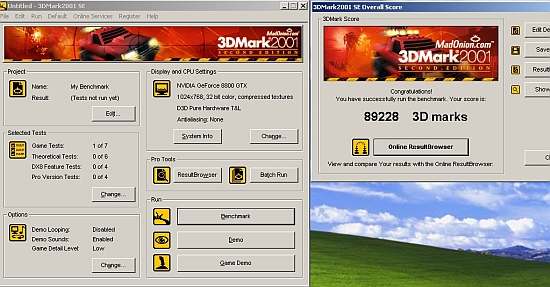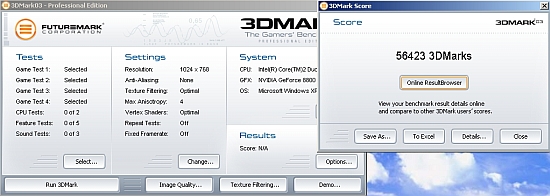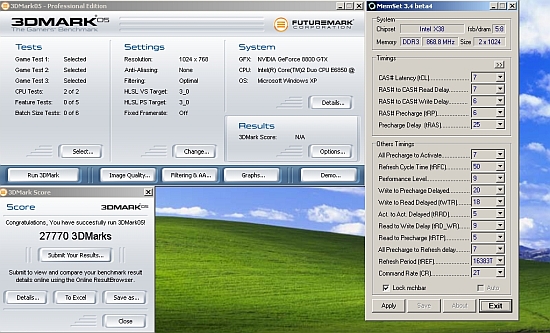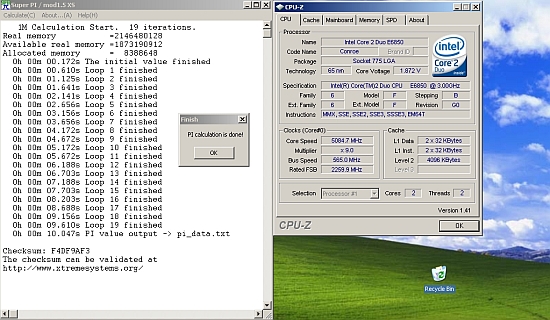ASUS Maximus Extreme - the Extreme Benchmarker's Choice?
by Rajinder Gill on December 10, 2007 8:00 AM EST- Posted in
- Motherboards
Extreme cooling results
| ASUS Maximus
Extreme Dual-Core Overclocking / Benchmark Testbed |
|
| Processor | Intel Core 2 Duo Q6850 Dual-Core, 3.00GHz, 4MB Shared Cache, 9x Multiplier, 1333FSB |
| CPU Voltage | 1.300V |
| Cooling | Various - Dual Rotary Cascades made by LittleDevil and Johann |
| Power Supply | OCZ Pro Xstream 1000w, PCP&C 1200w |
| Memory | OCZ DDR3 PC3-14400 (DDR-1800) Platinum Edition (2G/4GB) |
| Memory Settings | 4-4-4-12 1N (DDR3-1066 Base) |
| Video Cards | MSI 8800 GTX |
| Video Drivers | NVIDIA 169.09 |
| Hard Drive | Western Digital 7200RPM 250GB - WD2500KS |
| Optical Drives | Plextor PX-755A |
| Case | Dimastech benching table |
| BIOS | 0803 |
| Operating System | Windows XP Professional SP2 |
| . | |
3D Mark 2001SE CPU @ 4.88GHz GPU @ 861/1000
 |
3D Mark 2003 CPU @ 4.88GHz GPU @ 861/1000
 |
3D Mark 2005 CPU @ 4.88GHz GPU @ 861/1000
 |
Aquamark 3 - CPU @ 5.084GHz GPU @ 840/1000
 |
Super Pi 1M - CPU @ 5.084GHz
 |
The 266 Northbridge strap worked up to 550FSB for us; at higher FSB speeds, we used the 333 strap and the 5:8 memory divider. The lowest Performance Level (tRD) we managed to hold stable over 560FSB on both the 333 and 400 straps was 9. VNB on our test board needed to be at least 1.71V and up for runs over 540FSB. RAM was another area we did not stress too far. The board overvolts VDIMM by around 0.05V, so we try to stay under 2.2V even for short sprint benchmarks.
The extreme cooled benchmarking was the one area we thought this board would really excel, and initial testing was very promising. We had no problems booting up at 9x570FSB within the first 10 minutes of each benching session. As time progressed, we found that we had to drop the FSB levels in order for the board to remain stable. Initially, our E6850 CPU was showing no signs of error during 3D benchmark testing at 565FSB (5.085GHz). Ten minutes later, any attempts to repeat or improve our scores proved futile. We checked cascade evaporator temps and contact, to ensure that inadequate cooling under heavy load didn't cause the decrease in stability.
Ambient temperatures in our test area were 8C, providing both the CPU and GPU cascades with plenty of support under heavy load. We checked our findings with a few extreme benchmarkers, to see if this "cold-bug" issue only occurred on our sample motherboard. Unfortunately, the answers we received in reply all suggested similar issues. The first boot into XP over 5GHz CPU speed is no problem, but subsequent re-boot attempts are limited to CPU speeds under 4.95GHz. The issue itself does not appear to be limited to particular CPUs either; we have heard examples of 45nm QX9650's succumbing to the same problem. It is probable that this issue involves PWM overvoltage and/or over-current protection. Benchmarks like Super Pi 1M still are fine at higher FSB speeds, while a slightly heavier load like Aquamark 3 fails after the initial attempt.
In this case using less Vcore than the absolute threshold for the circuit to trip may actually help achieve better stability. In our case, the only workaround for this situation was to bench for 10 minutes at a time, shut the board down, let everything return to ambient temperatures and then start again. If this issue is common, users with LN2 will be again hunting for modifications/BIOS fixes and perhaps even board revisions to enable true extreme benchmarking. Due to this constant on/off procedure and the attendant time constraints, we were not able to fine-tune the board to its full capabilities. Still, we are satisfied with our results.










27 Comments
View All Comments
takumsawsherman - Tuesday, December 11, 2007 - link
This is not really true, as Firewire800 has been out for some time, and eSATA is still not widely available. As for the comment above yours, Firewire800 is used in many media applications, and won't likely be eliminated soon (digital camera backs come to mind). And this doesn't answer my proposition that for $350, Firewire800 rather than Firewire400 should have been included. Why bother with the slower interface when you are paying for a "premium" product?I am sure that some manufacturers will be happy to see Firewire800 die. Heck, I'm sure they'd be happy if there was never a Firewire400, and we all used USB 1.1. After all, it's cheaper by 2 or 3 bucks, and that's what matters to them. Meanwhile, despite claims of durability, eSATA is still a weak connector, which is why you will still see photographers taking shots tethered to a Firewire800 bus when they're on location for years to come, rather than a eSATA connection.
For $350, they can add Firewire800. Heck, the price is just shy of 1/3 of a fully assembled iMac that includes Firewire800. Just for the motherboard.
retrospooty - Tuesday, December 11, 2007 - link
"Firewire800 has been out for some time, and eSATA is still not widely available"Yes it is widely available. It has been on nearly every high end and many mid range motherboards for over a year. Also, every major external drive maker has eSATA models... Not many fw800 at all.
I am not trying to flame you or anything, but firewire 800 isnt going to happen, not like fw400 did. At the time fw400 was the best interface. Now we have eSATA for hard drives and USB 3.0 coming in a year or two. FW800 is dead Jim.... its dead.
takumsawsherman - Wednesday, December 12, 2007 - link
I still don't see any media-based hardware that has eSATA. Much more firewire on that front. In fact, besides Hard Drive enclosures, I have not seen anything at all with eSATA.And again, if it is dead, why bother putting FW400 in? I mean, might as well save the user $5 from their $350 and eliminate it. Or, give them FW800 like you should have.
strikeback03 - Wednesday, December 12, 2007 - link
I'd imagine it's there just so they can have a checkmark next to "Firewire" in the comparison sheets. The only Firewire device I have ever used is our microscope camera, which I believe was designed prior to USB 2.0.I wouldn't say the eSata connector is weak, but the lack of flexibility in the cables is an annoyance.
takumsawsherman - Wednesday, December 12, 2007 - link
Ok, well I still haven't used a eSATA device. I have used an external SATA enclosure, as MOBO makers decided to start out with external SATA connectors and I've used a FW800 device that also has an eSATA port (Newer Technology ministack v3), but of course, the Mac it is attached to does not have eSATA. I'm happy they included it, though.The point still remains that at $350 they give you the old generation firewire instead of the new.
retrospooty - Wednesday, December 12, 2007 - link
Are there any motherboards with fw800 built in (other than maybe MAC)? just curious.takumsawsherman - Tuesday, December 11, 2007 - link
OK, my post ended up as a reply to the wrong post. Sorry.retrospooty - Monday, December 10, 2007 - link
Yes, USB kb/mice work in dos mode via a bios setting. just enable it.Etern205 - Monday, December 10, 2007 - link
I'm taking about wireless. Are you talking about wireless or wired?If it's wired then yes you'll have enable usb support for DOS if you want to use it.
strikeback03 - Tuesday, December 11, 2007 - link
My Bluetooth keyboard works now, however when I first installed Ubuntu I had the BIOS setting disabled, and the keyboard never worked in GRUB thereafter. Was not until I reinstalled with the BIOS setting enabled that I got the keyboard working in GRUB.Works in the BIOS regardless of the setting.